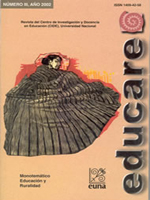Las escuelas unidocentes rurales como organizaciones de cambio
DOI:
https://doi.org/10.15359/ree.2002-3.12Abstract
The article reveals that multi-grade instruction schools emerged during the 1970s as a product of historical circumstances: the need to reduce the number of teachers according to the number of students. This decision was applied without providing for the quality of the school services (such as infrastructure or instructional material). Based on these experiences, the author analyzes the commitment that the universities must make with school with only one teacher assuming the position. She concludes with a list of challenges that these schools should keep in mind so that they can contribute to the transformation of rural communities.
References
Aldana, L. A. "La Calidad de las escuelas rurales" Artículo publicado en
La Prensa en el WEB, 6 de agosto 2000. Honduras on line.
Arnaut, A. (1994). Historia de una profesión. Maestros de educación primaria en México (1887-1994), México, Centro de Investigación y Docencia Económicas.
Ezpeleta, J. y Weiss E. (1994). et al.: Evaliwción cualitativa del Programa para abatir el rezago educativo, Informe Final. México, Departamento de Investigaciones Educativas del CINVESTAV-IPN.
Ferreiro, E. y Rodríguez, B. (1994). las condiciones de alfabetización en el medio rural, México, CINVESTAV- W. K. Kellog Foundation.
Fuenlabrada, l. y Weiss E. (Coordinadores); Candela A.; Ezpeleca, J.;
Kalman, J.; Mercado, R. (1997). las prácticas escolares y docentes en las escuelas unidocente de la educación primaria. Informe Final, México, Departamento de Investigaciones Educativas del CINVESTAV-IPN.
Gobierno de Jamaica. El Programa Externo de la Escuela hacia la Comunidad (SCOPE) Documento publicado en Web el 18 de Agosto 2002. Sitio del Ministerio de Educación y Cultura de Jamaica.
Pontificia Universidad Católica de Chile. Proyectos Operativos sobre Reforma Educativa Chilena Documento en WEB de la Universidad.
Suárez, A. y Rockwell, E. (1978). Evaluación del sistema de cursos comunitarios. México, CONAFE-COPIDER.
Published
How to Cite
Issue
Section
License
1. In case the submitted paper is accepted for publication, the author(s) FREELY, COSTLESS, EXCLUSIVELY AND FOR AN INDEFINITE TERM transfer copyrights and patrimonial rights to Universidad Nacional (UNA, Costa Rica). For more details check the Originality Statement and Copyright Transfer Agreement
2. REUTILIZATION RIGHTS: UNA authorizes authors to use, for any purpose (among them selfarchiving or autoarchiving) and to publish in the Internet in any electronic site, the paper´'s final version, both approved and published (post print), as long as it is done with a non commercial purpose, does not generate derivates without previous consentment and recognizes both publisher's name and authorship.
3. The submission and possible publication of the paper in the Educare Electronic Journal is ruled by the Journal’s editorial policies, the institutional rules of Universidad Nacional and the laws of the Republic of Costa Rica. Additionally, any possible difference of opinion or future dispute shall be settled in accordance with the mechanisms of Alternative Dispute Resolution and the Costa Rican Jurisdiction.
4. In all cases, it is understood that the opinions issued are those of the authors and do not necessarily reflect the position and opinion of Educare, CIDE or Universidad Nacional, Costa Rica. It is also understood that, in the exercise of academic freedom, the authors have carried out a rogorous scientific-academic process of research, reflection and argumentation thar lays within the thematic scope of interest of the Journal.
5. The papers published by Educare Electronic Journal use a Creative Commons License:














 The articles published by Educare Electronic Journal can be shared with a Creative Commons License:
The articles published by Educare Electronic Journal can be shared with a Creative Commons License: 



